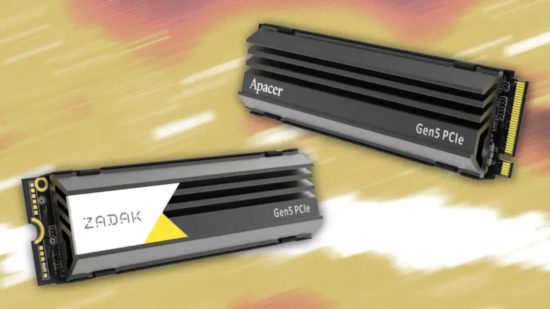At Computex this year, Phison showed the first PCIe 5 SSD controller in action on an upcoming Asus ROG X670E Hero motherboard with an AMD Ryzen 7000-series CPU. Phison’s new E26 SSD controller recorded a whopping 12.5GB/sec sequential read speed, and a sequential write speed a smidge over 10GB/sec. When compared to the peak ~7GB/sec sequential speeds of the fastest PCIe 4 SSDs, it’s clearly a huge upgrade.
The SSD was connected directly to the CPU for maximum performance, but you won’t need to buy the most expensive X670E chipset to get a PCIe 5 SSD socket. AMD has committed to having at least one PCIe 5 M.2 socket on all its motherboard chipsets, whether it’s X670E, X670 or even the mainstream B650. These next-gen SSDs will also be bigger than their predecessors – PCIe 5 SSDs will measure 25mm wide (2580), instead of the 22mm (2280) used now.
Apacer and Zadak have announced SSDs using the Phison E26 controller for later this year, which gives us a good insight into availability. Those brands aren’t typically a first choice on most people’s shopping lists, but Phison should supply the chip to other partners as well.
Phison’s demo did let slip one area with no performance gains, however. Its 4K single-queue-depth result – a typical workload for a home/gaming PC – was just 62MB/sec, which is pretty much the same as an average PCI-E 3 SSD. It remains to be seen if real-world speed will see a boost, but it’s unlikely to be as revolutionary as the headline numbers suggest.
For example, a 1st-gen Intel Optane 900p drive, which launched in 2017, might only produce 2.5GB/sec sequential speeds, but its 4K single-queue-depth performance is around 220MB/sec – over 3.5x faster than the new PCIe 5 drives.
Sadly, we won’t see another Optane drive out of Intel, and alternative technologies, such as spin-torque (STT), ReRAM or other phase-change storage products aren’t materialising either. It’s a bit frustrating that five years later, standard SSDs still haven’t caught up with Optane in some essential metrics. That might soon change though.
At its recent investor day conference, Micron announced a new 232-layer 1Tb TLC 3D NAND chip. In comparison, the most advanced 3D NAND today has a maximum count of ~160-176 layers. Micron noted that its new 3D NAND uses a combination of external and internal controllers for data storage. Micron clarified that it’s building a micro SSD controller into the NAND chip itself, offloading low-level functions, such as wear levelling and garbage collection, from the main SSD controller, freeing the latter to focus on user-centric work.
Micron explained that its design uses a wide bus inside each NAND chip, so it could efficiently handle its own operations and external requests, while the bus between the NAND and the main SSD controller is now narrower, owing to the reduced traffic. This reduces request latency, which boosts overall performance, and it improves power efficiency, because the data self-management never leaves the NAND chip. At a time when even PCIe 4 SSD controllers are frequently temperature throttling under heavy load, this is a very welcome design change.
The Phison demo did use Micron TLC NAND, but not the new 232-layer variety. It’s also unknown whether Phison’s controller can use Micron’s new NAND either, given that the E26 controller is already heading into production, and Micron’s latest 3D NAND has only just been announced. However, this may be addressable in firmware updates, or perhaps 2nd-generation PCIe 5 SSDs will demonstrate better real-world results beyond the headline numbers.
